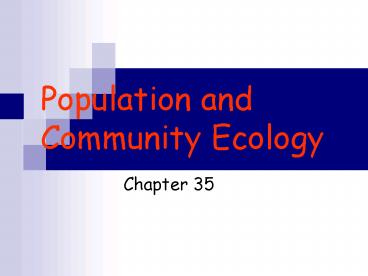Population and Community Ecology - PowerPoint PPT Presentation
1 / 29
Title:
Population and Community Ecology
Description:
Commensalism. Competition Between Species ... Commensalism. One organism benefit while the other is neither benefited nor harmed ... – PowerPoint PPT presentation
Number of Views:237
Avg rating:3.0/5.0
Title: Population and Community Ecology
1
Population and Community Ecology
- Chapter 35
2
Defining Populations
- Populations change over time? decrease or
increase - Factors that influence size
- Availability of food and space
- Weather conditions
- Breeding patterns
- To study the effects of these factors ecologists
define the geographic boundaries of a population
3
Population Density
- The number of individuals of a particular species
per unit area or volume. - Is a helpful measurement for comparing
populations in different locations. - Population density Individuals/Unit Area
- Ex 1000 trees in an area of 50Km2
- PD 1000/ 50Km2 20 trees /Km2
4
Sampling Techniques
- Quadrats A particular area is marked off then
the number of a particular species within this
boundary is counted. - Indirect Counting Certain organisms that move
around a lot or are difficult to see, therefore
nests, burrows, or tracks are counted rather than
the organisms themselves. - Mark-Recapture Organisms are captured, marked
and then released. Later organisms are captured
and the marked and unmarked ones are counted
5
Limits to Accuracy
- Quadrat Method? popln distributed evenly? not
so,if quadrat includes clumps ? s too high,if
not ? s too low - Mark-Recapture? captured animals wary of traps,
avoid traps? size is overestimated
6
Limits to Population Growth
- Section 35.2
7
Exponential Growth of Populations
- Population multiplies by a constant factor at
constant time intervals. - One cell becomes 2, every 20 minutes the
population doubles
8
Carrying Capacity
- The number of organisms in a population that the
environment can maintain, or carry, with no net
increase or decrease. - Limiting Factor a condition that can restrict a
population's growth. - Ex Space, disease and availability of food.
9
Factors Affecting Population Growth
- Density-Dependent Factors
- Food, diseases
- Density-Independent Factors
- Extreme weather events, such as hurricanes,
blizzards, ice storms, and droughts, have the
same effect on a population regardless of its
size. - Population Growth CyclesSome populations have
"boom-and-bust" growth cycles They increase
rapidly for a period of time (the "boom"), but
then rapidly decline in numbers (the "bust").
10
Predicting Human Population Growth
- CH 35.3
11
Age Structure
- The proportion of people in different age groups.
- Can predict future trends, and help determine
the earths carrying capacity
12
Species Interaction
- Ch 35.4
13
Species Interactions
Commensalism
Predation
Parasitism
Competition
Mutualism
14
Competition Between Species
- Interspecies Competition Two or more species
compete for the same source of food or shelter - Competitive Exclusion Two similar species,
having the same requirements, one succeeds over
the other
15
Predation
- One species hunt and kills another for food
- Both the predator and the prey have adaptations
that help them either to catch the prey, or to
avoid being caught.
16
Parasitism
- One organism obtains food at the expense of
another - Ex mosquitoes, tapeworms that live and feed in
the intestines of animals
17
Mutualism
- Both organisms benefit from this relationship
18
Commensalism
- One organism benefit while the other is neither
benefited nor harmed
19
Disturbances to Communities
- Ch 35.5
20
How Ecosystems Change
- Ecosystems are in a state of continual change
- Populations are slowly replaced by other/new
populations - Humans can also cause changes
21
Succession
- A regular pattern of changes in the type of
species of a community
22
Succession
- Causes
- New community makes it difficult for the old to
survive - Ex Pine shade ? pine seedling cant grow? oak,
maple grow? replace the pine trees
23
Succession
- Climax Community the community that is
eventually formed if the land is left undisturbed
24
Primary Succession
- Succession that occurs on surfaces where no
ecosystem existed - Ex New Islands, glaciers retreats, cracks in
rocks
25
Secondary Succession
- Succession that occurs on a surface where an
ecosystem had previously existed.
26
Secondary Succession
- Pioneers
- The first organism to colonize a newly available
area and start the process of succession
27
Secondary Succession
28
Human Activities and Species Diversity
- Clearing Land? farming, building, urbanization?
loss of species - Introduced Species
29
Exotic Species
- Species not native to an area
- Native species have no natural defense against
them































